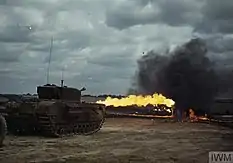F.R.A.S. (weapon)
Fuel Research Aluminium Stearate (FRAS), is mixture of chemical substances, used as an incendiary agent by United Kingdom during the Second World War. It is hygroscopic fuel, composed of "aluminium stearate", petrol, and peptized by xylenol, developed by the Fuel Research Station of the Department of Scientific and Industrial Research.[1]

In the conflict in Europea, it was the K fuel of the M1A1 flamethrower.[2] Delivered ready to use.[3] It was used as fuel for individual flamethrowers, for the Churchill Crocodile flamethrower tank, and as a precursor in the 5B incendiary paste used in the flame-fougasse.
It was adopted by the Canadian Army (1942) and War Office (1943).[4]
History
After the start of the Second World War, concerned with the development, research and technical mastery of incendiary mixtures, the Mixture Committee was formed in the second half of the year 1940 by the Director of Fuel Research, Dr. Frank Sturdy Sinnatt.[lower-alpha 1] The development of material, such as a substitute for rubber, was started in January 1942, in several works, by several members of the committee.[5]
The initial component was the most commercially available sodium stearate (FRSS), but the gel underwent syneresis. It was then opted for its respective aluminium salt. The work on this component was the most important. The gelling power of aluminium stearate has been known.[6]
In early investigative work, the standard component was rubber, being the constituent in several incendiary mixtures. Its anomalous viscosity being essential for flamethrower fuel. The use of this component deteriorated with the fall of Malaysia in February 1942.[7]
With this series of events, efforts were directed towards the feasibility and standardization of aluminium stearate. The initial results of the development of the thickened fuel turned out to be unsatisfactory. An additive remedied the deficiencies of the gel.[5] After this resolution, a special investigation into the manufacture of soaps was carried out, solving the problems of the thickener.[7]
Work with F.R.A.S. gels was then carried out at the Fuel Research Station until fuel production was taken over by the Ministry of Supply. The Fuel Research Station continued to serve as an advisor on the industrial scale production and improvement of F.R.A.S. and its precursors,[8] of which around 41 million litres were manufactured and used in the European theatre.[7]
Military use
The service fuel has undergone various degrees of requirements, both due to the seasons and the war zone. In general, production plants prepared two types of fuel for flamethrowers.[7]
F.R.A.S. was mainly used in Europe, designated for the M1A1 flamethrower as British "K" (FTF, Heavy No. 1). The British fuel was widely used by American forces and some units used it in preference to napalm. The napalm gel had a tendency to channel, resulting in incomplete exhaustion of the fuel.[2] Due to Britain's economic condition, K fuel was in short supply, particularly when the US Third Army landed on the continent.[2]
Transport and handling
The batches of fuel were conditioned in drums, then stored in open spaces and in a stacked manner. The transfer process, to flamethrowers or other devices, were problematic, particularly for mechanized flamethrower fuel.[7]
The process of working with the drum for Crocodile proved to be especially laborious, requiring the construction of a high structure and a side opening in the drum to facilitate its handling.[9] US Army flamethrower users were given a 5 US gallon "Jerrycan".[2]
Preparation
During World War II, Gel-Gas was prepared in batches using mobile plants. The process consisted of the digestion of the thickener in the liquid medium under special conditions.[7]
See also
- Napalm
- Isooctal
- Hydroxy-aluminum 2-ethylhexanoate
- Cam-gel (successor)
- "Aluminum hexanolate"
- Geletrol
- Lastol
- Aluma-gel
- Instant-gel
- Incendi-gel
- Rheal-I (40's german fuel thickener)
Notes
- replaced after his death in 1943 by Alfred Egerton
References
- Clark, R. War Winners - Part 4: Preparing For Invasion. p 3
- Historical Office, Office of the Chemical Corps. Special Staff, US Army. Chemical Corps Historical Studies, No. 4: Portable Flame Thrower Operations In World War II. 1 December 1949.
- Fletcher 2007, p. 21.
- Larson, C.A. Report #: 73. A Survey of Army Research and Development 1939-45. 14 Feb 1955.
- Cawley et al. 1947a.
- Licata, Francis J. (1 May 1938). "Aluminum Stearate Greases". Industrial & Engineering Chemistry. 30 (5): 550–553.
- Cawley et al. 1947b.
- OPDCIM-011. The Fuel Research Aluminium Stearate: The aluminium stearate (without additives). p 4 (Unclassified). p1-p25 (Sanitized)
- Fletcher 2007, p. 23.
Works cited
- Fletcher, David (2007). Churchill Crocodile Flamethrower. New Vanguard No. 136. Osprey Publishing. ISBN 978-1-84603-083-3.
- Cawley, C.M.; Carlile, J.H.G.; King, J.G.; Kingman, F.E.T. (November 1947a). "Aluminium Stearate Gels in Light Hydrocarbon Oils" (PDF). Journal of the Institute of Petroleum Engineers. 33 (287): 649–672.
- Cawley, C.M.; Carlile, J.H.G.; King, J.G.; Kingman, F.E.T. (December 1947b). "Aluminium Stearate Gels for Use as Flame-Thrower Fuels". Journal of the Institute of Petroleum Engineers. 33 (288): 721–755.
External links
- Churchill Crocodile Flame-throwing Tanks (Part 1) (Film). Imperial War Museum. 1944. Film number A70 135-7.
- Churchill Crocodile Flame-throwing Tanks (Part 2) (Film). Imperial War Museum. 1944. Film number A70 135-8.
- Training With Churchill Crocodile Flamethrowing Tanks (Part 1) (Film). Imperial War Museum. 1944. Film number A70 11-1.
- Training With Churchill Crocodile Flamethrowing Tanks (Part 2) (Film). Imperial War Museum. 1944. Film number A70 11-2.
- PETROLEUM WARFARE MATERIAL (Film). Imperial War Museum. 1943. Film Number: WOY 770.
- BURNING DOWN BELSEN CONCENTRATION CAMP (Part 1) (Film). Imperial War Museum. 1945. Film Number: A70 337-1.
- BURNING DOWN BELSEN CONCENTRATION CAMP (Part 2) (Film). Imperial War Museum. 1945. Film Number: A70 337-2.